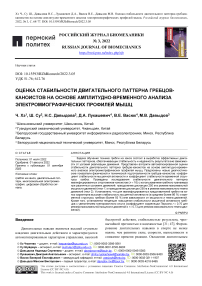Оценка стабильности двигательного паттерна гребцов-каноистов на основе амплитудно-временного анализа электромиографических профилей мышц
Автор: Хэ Ч., Су Ш., Давыдова Н.С., Лукашевич Д.А., Васюк В.Е., Давыдов М.В.
Журнал: Российский журнал биомеханики @journal-biomech
Статья в выпуске: 3 (97) т.26, 2022 года.
Бесплатный доступ
Задача обучения технике гребли на каноэ состоит в выработке эффективных двигательных паттернов, обеспечивающих стабильность и надежность результата вне зависимости от условий реализации движения. Представлен алгоритм автоматизированной оценки стабильности двигательного паттерна гребцов-каноистов на основе амплитудно-временного анализа электромиографических профилей мышц. Предложены новые диагностические показатели физической и технической подготовленности гребцов-каноистов: коэффициент стабильности мышечной активности и коэффициент стабильности временной структуры гребка. Проведены исследования стабильности двигательного паттерна квалифицированных спортсменов-каноистов ( n = 16) с использованием гребного тренажера при различных условиях движений: преодоление дистанции 250 м в режиме максимальной мощности движений (тест 1) и преодоление дистанции 250 м в режиме максимального темпа движений (тест 2). Установлено, что для квалифицированных представителей гребли на каноэ характерна высокая стабильность мышечной активности (в среднем более 86 %) и временной структуры гребков (более 93 %) вне зависимости от мощности и темпа движений. Кроме того, установлена тенденция повышения стабильности мышечной активности гребцов с увеличением тренировочного опыта (коэффициент корреляции Пирсона r = 0,70 для режима максимальной мощности движений и r = 0,73 для режима максимального темпа движений).
Гребля на каноэ, двигательный паттерн, многоканальная электромиография, цифровая обработка сигнала
Короткий адрес: https://sciup.org/146282601
IDR: 146282601 | УДК: 51-76, | DOI: 10.15593/RZhBiomeh/2022.3.05
Текст научной статьи Оценка стабильности двигательного паттерна гребцов-каноистов на основе амплитудно-временного анализа электромиографических профилей мышц
Двигательные навыки являются высшей ступенью владения двигательным действием и характеризуются автоматизированным характером управления, высокой быстротой действия, стабильностью результата, чрезвычайной прочностью и надежностью [31 ; 47]. Формирование двигательных навыков в спорте не менее важно, чем развитие силы, скорости, выносливости и снижение времени реакции. Овладение двигательным
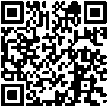

Эта статья доступна в соответствии с условиями лицензии Creative Commons Attribution-NonCommercial 4.0 International
License (CC BY-NC 4.0)
This work is licensed under a Creative Commons Attribution-NonCommercial 4.0 International License (CC BY-NC 4.0)
навыком означает более высокую эффективность движений, экономичность усилий и улучшение спортивного результата [39].
Гребля на каноэ является одним из наиболее популярных видов гребного спорта. Анализ последних исследований показывает, что в данной области ведутся разработки новых методологических и педагогических подходов к развитию двигательных навыков гребцов-каноистов [9; 10; 13; 34; 37].
Стабильность двигательного навыка достигается многократным воспроизведением движения в самых различных условиях с изменениями деталей кинематической, динамической и ритмической характеристик движения [28]. Это может происходить при усложнении внешних условий (условия опоры, ограничение пространства), изменениях в физическом и психическом состояниях (при утомлении, отвлечении внимания, волнении) или при возрастающих физических нагрузках [7; 35; 48]. Для гребцов наиболее значимыми факторами, влияющими на эффективность техники гребли, являются темп и мощность движения [1; 30; 32]. Следует полагать, что те же факторы будут значимы и для гребцов-каноистов.
Двигательный навык характеризуется совокупностью двигательных паттернов (стереотипов), которые представляют собой устойчивый комплекс угловых и линейных перемещений звеньев тела во времени за счет последовательной активации набора мышечных групп [26; 42]. Вариабельность биомеханических и электрофизиологических параметров двигательного навыка при различных внешних или внутренних условиях реализации движения является показателем несовершенства двигательного акта, поскольку это свидетельствует о повышении затрат мышечной энергии на коррекцию и поддержание двигательных паттернов [2].
Задача оценки стабильности двигательного паттерна в различных условиях является актуальной для многих видов спорта [21]. В области гребли на каноэ также есть несколько научных работ по данной теме, однако они основываются исключительно на кинематическом анализе гребного хода [27; 40; 50]. В представленной работе для решения данной задачи предлагается амплитудно-временной анализ многоканальных электромиограмм при выполнении гребковых движений. Кроме того, для расширения диагностического потенциала электромиографических сигналов используется совместный анализ с кинематическими параметрами движения.
Следует отметить, что электромиография успешно применяется в области гребного спорта для исследования межмышечной координации [25; 38; 46] и мышечной синергии [41; 43; 44]. Многоканальная электромиография позволяет оценить участие мышц в различных движениях, последовательность их включения и выключения, интегральный уровень возбуждения, соотношение активности мышц в разные периоды формирования движения [33].
Проведенный аналитический обзор научных работ показывает, что на сегодняшний день нет работ, посвященных оценке стабильности двигательного паттерна гребцов-каноистов с использованием многоканальной электромиографии. Таким образом, цель представленной работы является актуальной и посвящена разработке и апробации алгоритма оценки стабильности двигательного паттерна гребцов -каноистов на основе амплитудно-временного анализа электромиографических профилей мышц. Предполагается, что амплитудно -временной анализ электромиографических профилей мышц позволит выявить значимые диагностические показатели физической и технической подготовленности гребцов на каноэ.
Методология
Участники и порядок проведения исследований
В исследованиях принимали участие профессиональные гребцы-каноисты, имеющие многолетний опыт выступлений на чемпионатах Мира, чемпионатах Европы и Олимпийских играх. В исследовании приняли участие 16 спортсменов (женщины, возраст от 20 до 27 лет, 8 правшей, 8 левшей). Всем участникам предварительно объяснили суть исследования и показали тестовые упражнения. Участники были полностью здоровы и дали письменное согласие на участие в исследовании. Эксперименты проводились в соответствии с Хельсинкской декларацией и были одобрены экспертной комиссией Белорусского национального технического университета.
В работе применялась традиционная техника гребли на каноэ [24]. В этом случае гребок можно разделить на опорную фазу (проводка) и безопорную фазу (возврат) [12]. Во время проводки в начале гребка осуществляется захват лопастью весла воды, далее каноэ получает ускорение за счет опоры весла о воду, и затем следует выход лопасти из воды. Во время возврата гребец перемещает плечи, руки и весло вперед, готовясь к следующему гребку.
Исследование двигательного паттерна гребцов-каноистов осуществлялось в лабораторных условиях с использованием специализированных тренажерных устройств (гребных эргометров). В ходе исследования спортсмены выполняли два тестовых задания:
-
- тест 1: преодоление дистанции 250 м в режиме максимальной мощности движений. Спортсмену предлагалось тестовое задание с акцентированным выполнением опорной фазы гребка, характеризующееся максимальным или около максимальным силовым обеспечением для наибольшей длины проката за гребок. Темп гребли в рамках этого тестового задания умеренный, индивидуальный, исходя из режима интенсивности по пульсу (130-140 уд./мин);
-
- тест 2: преодоление дистанции 250 м в режиме максимального темпа движений. Спортсмену предлагалось тестовое задание с максимальным темпом. Этот режим позволяет смоделировать соревновательное прохождении дистанции. Величина темпа индивидуальна для каждого
согласно уровню его физической и технической подготовленности.
Тестовые задания подобраны таким образом, чтобы обеспечить возможность сравнения двигательных паттернов спортсменов, выявить и описать различия в активности мышц и кинематической структуре движений, а также оценить стабильность техники гребли.
В качестве исследуемых мышечных групп были выбраны: большая грудная мышца (Pectoralis major ), широчайшая мышца спины ( Latissimus dorsi ), прямая мышца живота ( Rectus abdominis ), двуглавая мышца плеча ( Biceps bra-chii ), трехглавая мышца плеча ( Triceps brachii ), прямая мышца бедра ( Rectus femoris ). Выбор мышц основан на их активном вовлечении в процесс гребли [29; 36; 45].
Для исследования работы мышц в процессе гребли использовалась многоканальная интерференционная электромиография. Данный метод является удобным и безболезненным инструментом, который позволяет регистрировать биоэлектрическую активность нескольких мышц одновременно. Это дает возможность определить наиболее активно вовлекаемые в движение мышечные группы и выявить характер распределения усилий между ними [33].
Для анализа пространственно-временных параметров гребли использовались располагаемые на исследуемых мышцах инерциальные MEMS -гироскопы, которые позволяют измерять угловую скорость звеньев тела в процессе движения [19].
Инструментарий и сбор данных
Для исследований использовался гребной тренажер Dansprint Ergometer ( Dansprint , Дания) с неподвижным основанием. Нагрузка задавалась посредством регулирования величины отверстий на маховике. В ходе тестирования спортсмены использовали древки весел с индивидуальными рукоятками.
Регистрация электромиографических сигналов мышц и сигналов гироскопа осуществлялась с помощью беспроводной системы Trigno Wireless System c Trigno Avanti Sensors ( Delsys Inc ., USA ). Каждый беспроводной датчик позволяет регистрировать один канал электромиографии (полоса пропускания 10–850 Гц, входной диапазон до 22 мВ, разрешение 16 бит), 3 канала гироскопа (три оси координат, частота дискретизации 741 Гц, разрешение 16 бит), передавать данные по Bluetooth на расстояние до 40 м [17].
Фиксация и расположение датчиков на исследуемых мышцах, их ориентация относительно двигательных волокон, качество подготовки поверхности кожи для регистрации поверхностной электромиографии проводились в соответствии с рекомендациями SENIAM [22].
Запись электромиографии и сигналов гироскопа осуществлялась с помощью программного обеспечения Delsys Acquisition Software ( Delsys Inc ., USA ). Дальнейший анализ данных проводился в программной среде для решения задач технических вычислений MATLAB ( MathWorks , USA ). Для этого было разработано авторское программное обеспечение, которое посредством инструмента Delsys
EMGworks COM interface сопрягается с системой Trigno Wireless System [3].
Анализ данных
На сегодняшний день наблюдается тенденция автоматизации вычислительных процессов анализа и интерпретации биомедицинских данных, за счет чего повышаются скорость, достоверность и качество результатов исследований. Программная реализация алгоритмов обработки биомедицинских данных позволяет проводить сравнительный анализ не единичных спортсменов, а целых спортивных команд. Кроме того, автоматизация вычислений существенно уменьшает вероятность ошибки при обработке больших массивов биомедицинских данных [23].
На рис. 1 представлен алгоритм автоматизированной оценки стабильности двигательного паттерна гребцов-каноистов на основе амплитудно-временного анализа элек-тромиографических профилей мышц. Согласно разработанному алгоритму процедура количественной оценки стабильности двигательного паттерна гребцов-каноистов происходит в следующей последовательности.
На начальном этапе осуществляется выбор целевых электромиографических сигналов и сигналов гироскопа. Данная задача решается индивидуально и зависит от типа и структурной сложности исследуемого движения. В случае гребли целесообразно исследование работы мышц рук, груди, спины и живота [45].
При выборе целевых сигналов гироскопа необходимо руководствоваться кинематической моделью человека, представляющей собой систему рычагов с различной степенью свободы, соединенных суставными организациями [20]. Такая модель описывает движение как результат угловых и линейных перемещений звеньев тела во времени [18]. Для выделения циклов гребли в работе были выбраны сигналы гироскопа с датчиков, расположенных на дельтовидной мышце ( Deltoideus ). При этом для спортсменов, выполняющих опорную фазу гребка слева, использовались сигналы гироскопа с дельтовидной мышцы левой руки. Для спортсменов, выполняющих опорную фазу гребка справа, использовались сигналы гироскопа с дельтовидной мышцы правой руки. Выбор сигналов гироскопа обусловлен следующими факторами. Во-первых, плечо тянущей руки спортсмена при выполнении опорной фазы гребка движется преимущественно в сагиттальной плоскости без явно выраженных ротационных движений и смещений в другие плоскости. Более того, плечевой сустав содержит в себе оси вращения плеча и, соответственно, всей руки в целом, что существенно снижает степень воздействия на сигнал гироскопа двигательных помех.
Благодаря этому измеряемый сигнал гироскопа с датчика, расположенного на дельтовидной мышце тянущей руки спортсмена, позволяет безошибочно определить опорную и безопорную фазы гребка. Во-вторых, авторами проведены исследования техники гребли на каноэ с использва-нием синхронизированной записи сигналов гироскопа и видеосъемки. В результате чего было установлено, что пол-
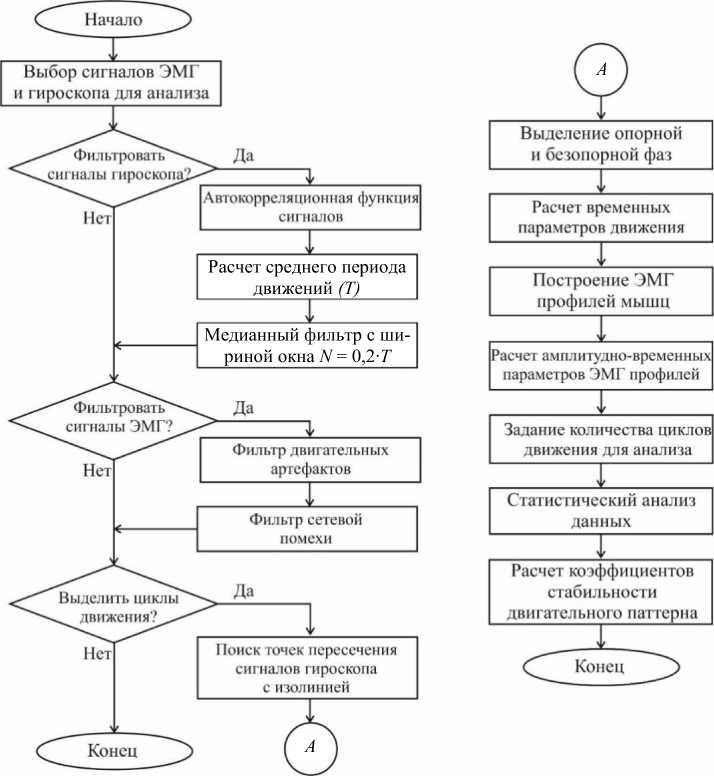
Рис. 1. Алгоритм оценки стабильности двигательного паттерна гребцов-каноистов. ЭМГ - электромиография
ожительные значения сигнала гироскопа с датчика, расположенного на дельтовидной мышце тянущей руки спортсмена, соответствуют опорной фазе гребка [4].
Сигналы инерционного гироскопа представляются в виде проекций вектора угловой скорости ( w , º/с) на связанные с объектом оси [49]. Фильтрация сигналов гироскопа осуществляется с помощью медианного фильтра с динамическим окном. Медианный фильтр осуществляет усреднение заданного числа точек из входного сигнала для вычисления каждой точки в выходном сигнале [6]. Ширина окна ( N) медианного фильтра выбирается динамически и зависит от периода движения ( T ). Усредненный период движения определяется как период автокорреляционной функции сигнала гироскопа. Автокорреляционная функция сигнала [6] рассчитывается по формуле:
1 N - 1
r xx (j) = ^X i = 0 x(i) ' x( i + j), (1) где x(i), i = 1, N - дискретный сигнал гироскопа, содержащий N элементов, j = 0, N - величина задержки.
Следующим этапом является фильтрация сигналов многоканальных электромиограмм с целью удаления двигательных артефактов и сетевой помехи из спектра полез- ного сигнала [16]. Для фильтрации двигательных артефактов используется фильтр высоких частот с частотой среза 10 Гц, для сетевой помехи - режекторный фильтр 50 Гц. При конструировании названных фильтров необходимо обеспечить минимизацию амплитудных и фазовых искажений в полосе пропускания и заданное подавление сигнала в полосе задерживания [8]. Применение фильтров необходимо ограничить случаями реального зашумления полезного сигнала, так как любой фильтр вносит дополнительные фазовые и/или амплитудные искажения в исходный сигнал.
Далее осуществляется выделение циклов движения. Критерием выделения циклов гребли является пересечение сигнала гироскопа с изолинией, что соответствует остановке звена тела человека в определенном положении.
Точка i cross является точкой пересечения двух сигналов x(i) и y(i), если выполняется условие:
x^z )—y(i ) = 0. (2) cross y cross .
На рис. 2 представлен пример определения циклов гребли на основании найденных точек пересечения сигнала гироскопа (с дельтовидной мышцы) с изолинией. Выделение опорной и безопорной фазы гребка осуществляется на основе полярности сигнала гироскопа. Положительные значения угловой скорости (w, º/s) соответствуют опорной фазе гребка, отрицательные – безопорной фазе. В опорной фазе гребка спортсмен взаимодействует с поверхностью воды и осуществляет ускорение каноэ. Безопорная фаза гребка соответствует проносу весла и завершает двигательный цикл [11]. На основании детектированной временной структуры гребли рассчитываются следующие временные параметры движения: длительность циклов гребли, а также длительность опорной и безопорной фазы каждого гребка.
На следующем этапе осуществляется наложение детектированной временной структуры гребли на электромио-графические сигналы и построение электромиографиче-ских профилей исследуемых мышц. Электромиографиче-ский профиль представляет собой устойчивый пространственно-временной паттерн биоэлектрической активности мышцы, отображающий последовательность и степень активации мышцы в процессе выполнения конкретного движения [5]. На рис. 3 показан пример электро-миографического профиля мышцы Latissimus Dorsi левой стороны.
Для количественной оценки усилий, развиваемых мышцами в процессе гребли, рассчитываются амплитудновременные параметры электромиографических профилей мышц. В представленной работе осуществляется расчет энергии сигналов электромиографа в выделенных ранее циклах гребли (для опорной и безопорной фаз гребка) в соответствии с авторской методикой [14]. В целом энергия цифрового сигнала рассматривается не как физическая величина, а как средство сравнения различных сигналов [6]. В случае электромиографии, энергия сигнала пропорциональна усилию, развиваемому мышцей в процессе движения [15].
Оценка стабильности двигательного паттерна гребцов-каноистов осуществляется на основе статистического анализа амплитудных и временных параметров электромио графических профилей мышц при различных
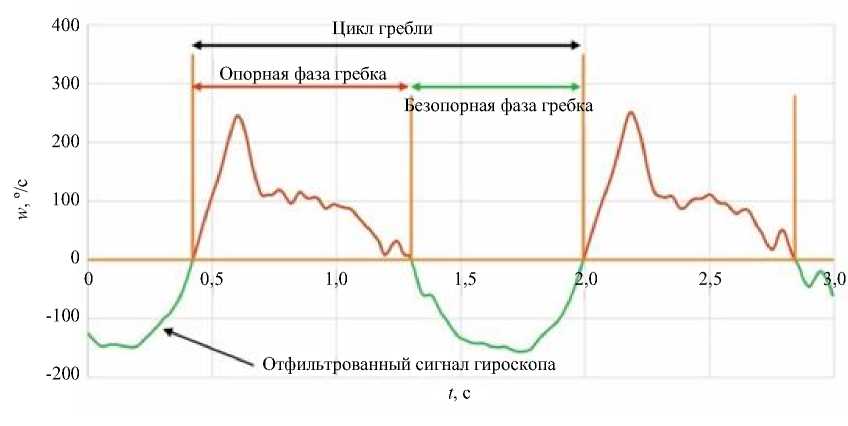
Рис. 2. Выделение циклов гребли
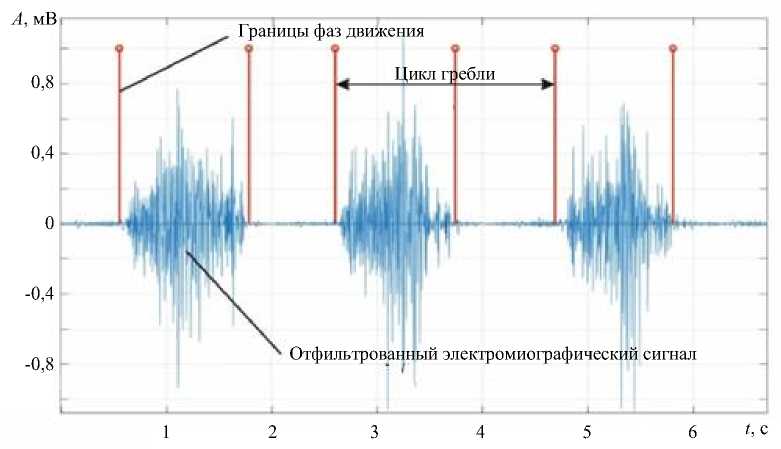
Рис. 3. Пример электромиографического профиля мышцы Latissimus Dorsi
условиях реализации движения. Для этого, в пределах заданного количества циклов гребли (не менее 10) определяется степень изменения следующих параметров: длительность цикла гребли ( T) , длительность опорной фазы гребка ( t ), энергия сигнала электромиографии исследуемых мышц в опорной фазе гребка ( E t ).
Для каждого цикла ( i ) гребли определяется отношение длительности опорной фазы гребка ( t ) к общей длительности цикла ( T) :
Δ ti =
ti
T i '
На заданном периоде наблюдения (определяется количеством циклов гребли N) рассчитывается среднее значение отношения длительности опорной фазы гребка к общей длительности цикла:
∑ N
∆ti a t- = —^=—. (4)
N
На заданном периоде наблюдения (N) рассчитывается среднеквадратичное отклонение отношения длительности опорной фазы гребка к общей длительности цикла:
/У N ( A t i -A t ср )2
A ' 1=1.11 =1'-
У = 0---------------.
N
На заданном периоде наблюдения ( N ) для каждой мышцы ( m ) рассчитывается среднее значение энергии сигнала электромиографии в опорной фазе гребка ( E t ):
N Ei г ср _ ^ i=1 '’ m
'•m = N
■
На заданном периоде наблюдения (N) для каждой мышцы (m) рассчитывается среднеквадратическое откло- нение энергии сигнала электромиографии в опорной фазе гребка:
У
1 Z N = 1 ( E m - E )2
N
.
Среднеквадратичное отклонение энергии сигнала электромиографии в опорной фазе гребка и отношения длительности опорной фазы гребка к общей длительности цикла характеризуют степень вариабельности электрофизиологических (биоэлектрической активности мышц), и кинетических (временных) параметров двигательного паттерна гребцов от цикла к циклу.
На заданном периоде наблюдения рассчитывается коэффициент стабильности временной структуры гребка:
Δt kA ‘ = (1 - V) '1°0%. (8)
Коэффициент стабильности временной структуры гребка имеет значение в диапазоне (0-100 %).
На заданном периоде наблюдения рассчитывается коэффициент стабильности мышечной активности:
у M (1 - у m )
m =1V E ср '
k E =-------- ‘m-
■ 100%,
M
где M - количество исследуемых мышц. Коэффициент стабильности мышечной активности имеет значение в ди- апазоне (0-100 %).
Таким образом, стабильность двигательного паттерна гребцов оценивается двумя показателями: коэффициентом стабильности мышечной активности и коэффициентом стабильности временной структуры гребка.
Результаты и их обсуждение
В результате проведенных исследований для каждого спортсмена были рассчитаны следующие параметры:
-
1. Коэффициент стабильности мышечной активности в режиме максимальной мощности движений ( k E ' , %) при выполнении теста 1. Позволяет оценить адаптивную способность к сохранению сформированного паттерна биоэлектрической активности мышц при высоких силовых нагрузках.
-
2. Коэффициент стабильности мышечной активности в режиме максимального темпа движений ( k E , %) при выполнении теста 2. Позволяет оценить адаптивную способность к сохранению сформированного паттерна биоэлектрической активности мышц при высоких темпах движения.
-
3. Коэффициент стабильности временной структуры гребка в режиме максимальной мощности движений ( к Л ' , %) при выполнении теста 1. Позволяет оценить адаптивную способность к сохранению ритма движения при высоких силовых нагрузках.
-
4. Коэффициент стабильности временной структуры гребка в режиме максимального темпа движений ( к Л ' , %) при выполнении теста 2. Позволяет оценить адаптивную способность к сохранению ритма гребли при высоких темпах движения.
Данные, характеризующие индивидуальную стабильность мышечной активности гребцов в режиме максимальной мощности движений ( k E ' , %) и в режиме максимального темпа движений ( k E , %), представлены в табл.
Анализ данных позволяет сделать вывод, что для квалифицированных представителей гребли на каноэ характерна высокая стабильность реализации паттерна биоэлектрической активности мышц во время гребли (в среднем более 86 %) вне зависимости от мощности и темпа движений. Это свидетельствует об эффективном овладении двигательными навыками и высоком уровне развития координационных способностей. При этом наблюдается тенденция повышения стабильности мышечной активности гребцов с увеличением тренировочного стажа (коэффициент корреляции Пирсона r = 0,70 для режима максимальной мощности движений и r = 0,73 для режима максимального темпа движений). Следует также отметить, что характер распределения мышечных усилий в опорной фазе гребка при выполнении тестов 1 и 2 не изменяется, но при этом наблюдается увеличение активности основных мышечных
Коэффициенты стабильности мышечной активности гребцов и временной структуры гребка
|
Спортсмены |
Возраст, лет |
Стаж занятий, лет |
k E t , % |
k E , % |
к Л t , % |
к Л , % |
|
1 |
20 |
7 |
87,23 |
85,12 |
95,49 |
95,82 |
|
2 |
21 |
7 |
80,11 |
81,31 |
95,88 |
94,99 |
|
3 |
21 |
8 |
82,02 |
84,47 |
69,38 |
93,91 |
|
4 |
21 |
9 |
85,90 |
86,39 |
96,70 |
97,02 |
|
5 |
22 |
8 |
86,34 |
81,09 |
96,66 |
96,06 |
|
6 |
22 |
10 |
83,29 |
88,03 |
74,97 |
95,46 |
|
7 |
22 |
10 |
85,48 |
85,64 |
95,33 |
96,31 |
|
8 |
23 |
9 |
87,07 |
88,66 |
95,70 |
95,62 |
|
9 |
23 |
9 |
85,13 |
87,34 |
97,95 |
96,99 |
|
10 |
23 |
10 |
85,32 |
83,71 |
97,09 |
96,57 |
|
11 |
23 |
11 |
87,26 |
86,39 |
96,10 |
97,25 |
|
12 |
24 |
13 |
85,32 |
88,23 |
94,86 |
95,98 |
|
13 |
25 |
15 |
90,36 |
88,50 |
97,11 |
96,05 |
|
14 |
26 |
13 |
94,06 |
90,79 |
96,82 |
96,17 |
|
15 |
26 |
14 |
89,60 |
89,95 |
96,48 |
97,17 |
|
16 |
27 |
16 |
90,41 |
88,99 |
96,67 |
96,83 |
|
Математическое ожидание ± среднеквадратичное отклонение |
23,20 ± 2,04 |
10,56 ± 2,83 |
86,55 ± 3,42 |
86,54 ± 2,85 |
93,32 ± 8,35 |
96,14 ± 0,88 |
Pectoralis major R
Pectoralis major R
Biceps brachii L
Latissimus dorsi L
Rectus abdominis L
Rectus femoris L
Triceps brachii L
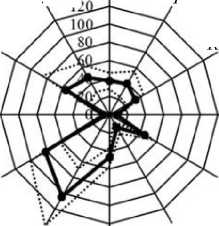
Rectus abdominis R
Rectus femoris R
Triceps brachii R
Biceps brachii R
Biceps brachii L
Rectus abdominis L
Latissimus dorsi R
Latissimus dorsi L
Rectus femoris L
Triceps brachii L
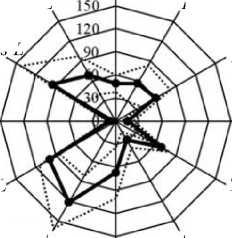
Rectus abdominis R
Rectus femoris R
Triceps brachii R
Biceps brachii R
Latissimus dorsi R
Pectoralis major L Математическое ожидание
Cреднеквадратичное отклонение
а
Pectoralis major R
Pectoralis major L Математическое ожидание Cреднеквадратичное отклонение б
Pectoralis major R
Biceps brachii L
Latissimus dorsi L
Rectus abdominis L
Rectus femoris L
Triceps brachii L
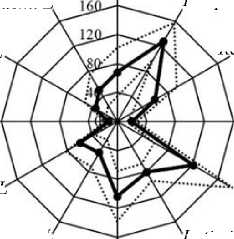
Biceps brachii R
Rectus abdominis R Rectus abdominis L
Latissimus dorsi R
Latissimus dorsi L
Triceps brachii R Triceps brachii L
Rectus femoris R
Rectus femoris L
Biceps brachii L
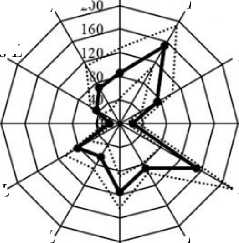
Rectus abdominis R
Rectus femoris R
Triceps brachii R
Biceps brachii R
Latissimus dorsi R
Pectoralis major L Математическое ожидание
Cреднеквадратичное отклонение в
Pectoralis major L Математическое ожидание Cреднеквадратичное отклонение г
Рис. 4. Распределения усилий исследуемых мышц в опорной фазе гребка: а - спортсмены-левши, тест 1; б - спортсмены-левши, тест 2; в – спортсмены-правши, тест 1; г – спортсмены-правши, тест 2
групп в режиме максимального темпа выполнения тестового задания.
Это связано с тем, что тестовое задание 2 характеризуется высокой интенсивностью, которую необходимо поддерживать в течение определенного промежутка времени. На рис. 4 представлены лепестковые диаграммы распределение биоэлектрической активности ( А , мВ) исследуемых мышц при выполнении тестов 1 и 2.
Данные, характеризующие индивидуальную стабильность временной структуры гребка в режиме максимальной мощности движений ( k Λ t , %) и в режиме максимального темпа движений ( k Λ t , %), представлены в табл.
Анализ данных позволяет сделать вывод, что для квалифицированных представителей гребли на каноэ характерна высокая стабильность ритма гребков вне зависимости от мощности и темпа движений. Это свидетельствует об эффективном овладении двигательными навыками и высоком уровне развития координационных способностей. При этом, в режиме максимального темпа движений стабильность временной структуры гребка выше ( k Λ t = 96,14 ± 0,88 %), чем в режиме максимальной мощности движений ( kp Λ t = 93,32 ± 8,35 %).
Таким образом, предложенный подход к анализу элек-тромиографических профилей мышц позволил выявить значимые диагностические показатели физической и технической подготовленности гребцов на каноэ, что подтверждается проведенными исследованиями стабильности двигательного паттерна высококвалифицированных каноистов.
Заключение
В работе рассмотрен алгоритм автоматизированной оценки стабильности двигательного паттерна гребцов-каноистов на основе амплитудно-временного анализа элек-тромиографических профилей мышц. Особенностью предложенного алгоритма является выявление новых диагностических показателей физической и технической подготовленности гребцов: коэффициентов стабильности мышечной активности и временной структуры гребка.
Проведенные в работе исследования показали эффективность предложенного подхода к оценке стабильности двигательного паттерна гребцов-каноистов. Установлено, что для квалифицированных представителей гребли на каноэ характерна высокая стабильность мышечной активности (более 86 %) и временной структуры гребков (больше 93 %) вне зависимости от мощности и темпа движений. Это свидетельствует об эффективном овладении двигательными навыками и высоком уровне развития координационных способностей. Кроме того, установлена тенденция повышения стабильности мышечной активности гребцов с увеличением тренировочного стажа (коэффициент корреляции Пирсона r = 0,7 для режима максимальной мощности движений и r = 0,73 для режима максимального темпа движений). Предложенный алгоритм автоматизированной оценки стабильности двигательного паттерна гребцов-каноистов может быть использован для объективного контроля процесса обучения технике гребли и своевременной ее коррекции, оценки степени восстановления двигательных навыков после травм опорно-двигательного аппарата, разработки новых критериев оценки эффективности решения двигательной задачи.
development of motor skills // Kinesiology Review. – 2018. – Vol. 7, № 2. – P. 99–114.
http://www.northbaycanoeclub.ca/wp-content/uploads/ 2009/12/Canoe-Technical-Template.pdf (дата обращения: 01 Мая 2022).
Финансирование. Научная работа выполнялась в рамках задания государственной программы развития физической культуры и спорта в Республики Беларусь на 2016–2020 гг. «Разработать методику оценки компонентов координационных способностей спортсменов на основе анализа биоэлектрической активности мышц в движениях со сложной двигательной структурой» (2019–2020, № гос. рег. 20191858).
Список литературы Оценка стабильности двигательного паттерна гребцов-каноистов на основе амплитудно-временного анализа электромиографических профилей мышц
- Верлин С.В., Семаева Г.Н., Маслова И.Н. Факторы, определяющие эффективность техники гребли // Ученые записки университета им. ПФ Лесгафта. - 2014. - № 4 (110). - С. 29-34.
- Давыдова Н.С. Аппаратно-программный комплекс многоканальной электромиографии для диагностики двигательных навыков человека: автореф. дис. ... канд. тех. наук . - Минск: БГУИР, 2012. - 23 с.
- Давыдова Н.С., Васюк В.Е., Парамонова Н.А. и др. Алгоритм анализа кинематических характеристик бега // Доклады Белорусского государственного университета информатики и радиоэлектроники. -2020. - Т. 18., № 8. - С. 37-45.
- Лукашевич Д.А., Васюк В.Е. Развитие силы ведущих групп мышц спортсменов-гребцов с использованием биологической обратной связи // Мир спорта. - 2018. -№ 1 (70). - С. 21-25.
- Петрушанская К.А., Витензон А.С. Трансформация электромиографического профиля мышц при патологической ходьбе // Российский журнал биомеханики. - 2002. - № 3. - С. 77-91.
- Akay M. Biomedical signal processing. - Academic press, 2012. - 392 p.
- Anderson D.I. Motor development: Far more than just the development of motor skills // Kinesiology Review. - 2018. - Vol. 7, № 2. - P. 99-114.
- Antoniou A. Digital filters: analysis, design, and signal processing applications. - McGraw-Hill Education, 2018. - 976 p.
- Bohuslavska V., Furman Y., Pityn M. et al. Improvement of the physical preparedness of canoe oarsmen by applying different modes of training loads // Journal of Physical Education and Sport. - 2017. - Vol. 17, №2 2. - P. 797-803.
- Brymer E. Skill development in canoeing and kayaking: An individualised approach // Motor Learning in Practice. -Routledge, 2010. - P. 152-160.
- Buday T. Canoe technical template. Canoe kayak canada [Электронный ресурс]. - URL: http://www.northbaycanoeclub.ca/wp-content/uploads/ 2009/12/Canoe-Technical-Template.pdf (дата обращения: 01 Мая 2022).
- Caplan N. The influence of paddle orientation on boat velocity in canoeing // International Journal of Sports Science and Engineering. - 2009. - Vol. 3, №2 03. - P. 131139.
- Chalubinska D., Truszczynska-Baszak A., Reszelewska A. et al. Twelve-week sensorimotor training as a factor influencing movement patterns of canoe slalom athletes, assessed by the functional movement screen // Biomedical Human Kinetics. - 2020. - Vol. 12, № 1. - P. 10-16.
- Davydova N., Davydov M., Osipov A. et al. Complex analysis of human movements based on the identification of amplitude-time characteristics of electromyographic patterns // Global Journal of Research in Engineering. -2019. - Vol. 19, № 5. - P. 15-26.
- Davydova N., Vasiuk V., Osipov A. et al. Estimation of athlete coordination abilities based on the reproducibility analysis of the electromyographic patterns of complex coordination movements // Journal of Engineering Science. - 2019. - Vol. XXVI, № 2. - P. 85-98.
- De Luca C.J., Gilmore L.D., Kuznetsov M. et al. Filtering the surface EMG signal: Movement artifact and baseline noise contamination // Journal of biomechanics. - 2010. -Vol. 43, № 8. - P. 1573-1579.
- Delsys. Trigno Wireless System [Электронный ресурс]. -URL: https://delsys.com/trigno/research/ (дата обращения: 01 Марта 2022).
- Dockstader S.L., Tekalp A.M. A kinematic model for human motion and gait analysis // Proc. of the Workshop on Statistical Methods in Video Processing (ECCV). -2002. - P. 49-54.
- Du J., Gerdtman C., Linden M. Signal quality improvement algorithms for MEMS gyroscope-based human motion analysis systems: A systematic review // Sensors. - 2018. -Vol. 18, № 4. - P. 1123.
- Duffy V.G. Handbook of digital human modeling: research for applied ergonomics and human factors engineering. -CRC press, 2016. - 1006 p.
- Elphinston J. Stability, sport, and performance movement: great technique without injury. - North atlantic books, 2008. - 336 p.
- Hermens H.J., Freriks B., Merletti R. et al. European recommendations for surface electromyography // Roessingh research and development. - 1999. - Vol. 8, № 2. - P. 13-54.
- Hoyt R., Muenchen R. Introduction to biomedical data science. - Lulu. com, 2019. - 258 p. Hunter M., Curinier S. Training for canoeing // Handbook of Sports Medicine and Science Canoeing. - 2019. - P. 7190.
- Janshen L., Mattes K., Tidow G. Muscular coordination of the lower extremities of oarsmen during ergometer rowing // Journal of Applied Biomechanics. - 2009. - Vol. 25, № 2. - P. 156-164.
- Latash M.L., Scholz J.P., Schöner G. Toward a new theory of motor synergies // Motor Control. - 2007. - Vol. 11. -№ 3. - P. 276-308.
- Limonta E., Squadrone R., Rodano R. et al. Tridimensional kinematic analysis on a kayaking simulator: key factors to successful performance // Sport Sciences for Health. - 2010. - Vol. 6, № 1. - P. 27-34.
- Luft A.R., Buitrago M.M. Stages of motor skill learning // Molecular neurobiology. - 2005. - Vol. 32, № 3. - P. 205216.
- Lukashevich D. Experimental substantiation of special training simulators application during canoeists' training process // Sporto mokslas. - 2017. - Vol. 3. - P. 40-46. Mackenzie H.A., Bull A.M., McGregor A.H. Changes in rowing technique over a routine one hour low intensity high volume training session // Journal of Sports Science & Medicine. - 2008. - Vol. 7, № 4. - P. 486.
- Magill R., Anderson D. Motor learning and control. - New York: McGraw-Hill Publishing, 2010. - 498 p.
- McGregor A.H., Bull A.M.J., Byng-Maddick R. A comparison of rowing technique at different stroke rates: a description of sequencing, force production and kinematics // International Journal of Sports Medicine. - 2004. - Vol. 25, № 06. - P. 465-470.
- Merletti R., Farina D. Surface electromyography: physiology, engineering, and applications. - John Wiley & Sons, 2016. - 592 p.
- Messias L.H.D., dos Reis I.G.M., Ferrari H.G. et al. Physiological, psychological and biomechanical parameters applied in canoe slalom training: a review // International Journal of Performance Analysis in Sport. -2014. - Vol. 14, № 1. - P. 24-41.
- Newell K.M. What are fundamental motor skills and what is fundamental about them? // Journal of Motor Learning and Development. - 2020. - Vol. 8, № 2. - P. 280-314.
- Pelham T.W., Burke D.G., Holt L.E. Sports performance series: the flatwater canoe stroke // Strength & Conditioning Journal. - 1992. - Vol. 14, № 1. - P. 6-9.
- Place N., Billat V. New field test to track changes of flatwater paddling performance: a preliminary study // Perceptual and Motor Skills. - 2012. - Vol. 115, № 3. - P. 933-936.
- Readi N.G., Rosso V., Rainoldi A. et al. Do sweep rowers symmetrically activate their low back muscles during indoor rowing? // Scandinavian Journal of Medicine & Science in Sports. - 2015. - Vol. 25, № 4. - P. e339-e352.
- Renshaw I., Davids K., Savelsbergh G.J. Motor learning in practice. - Routledge, 2010. - 272 p.
- Sealey R.M., Ness K.F., Leicht A.S. Effect of self-selected and induced slow and fast paddling on atroke kinematics during 1000 m outrigger canoeing ergometry // Journal of Sports Science & Medicine. - 2011. - Vol. 10, № 1. - P. 52-58.
- Shaharudin S., Zanotto D., Agrawal S. Muscle synergies of untrained subjects during 6 min maximal rowing on slides and fixed ergometer // Journal of Sports Science & Medicine. - 2014. - Vol. 13, № 4. - P. 793-800.
- Shumway-Cook A., Woollacott M.H. Motor control: translating research into clinical practice. - Lippincott Williams & Wilkins, 2007. - 680 p.
- So R.C., Michael A.T., Wong S.C. Application of surface electromyography in assessing muscle recruitment patterns in a six-minute continuous rowing effort // Journal of Strength and Conditioning Research. - 2007. - Vol. 21, № 3. - P. 724-730.
- Tomiak T., Gorkovenko A.V., Tal'nov A.N. et al. The averaged EMGs recorded from the arm muscles during bimanual "rowing" movements // Frontiers in Physiology. - 2015. - Vol. 6. - P. 349.
- Tortora G.J., Derrickson B.H. Principles of anatomy and physiology. - John Wiley & Sons, 2018. - 1248 p.
- Turpin N.A., Guevel A., Durand S. Effect of power output on muscle coordination during rowing // European Journal of Applied Physiology. - 2011. - Vol. 111, № 12. -P. 3017-3029.
- Wei G., Luo J. Sport expert's motor imagery: Functional imaging of professional motor skills and simple motor skills // Brain Research. - 2010. - Vol. 1341. - P. 52-62.
- Williams A.M., Hodges, N.J Skill acquisition in sport: Research, theory and practice. - Routledge, 2012. - 385 p.
- Woodman O.J. An introduction to inertial navigation. -University of Cambridge, Computer Laboratory, 2007. - №. UCAM-CL-TR-696.
- Zahalka F., Maly T., Mala L. et al. Kinematic analysis of Canoe stroke and its changes during different types of paddling pace-case study // Journal of Human Kinetics. -2011. - Vol. 29. - P. 25-31.

